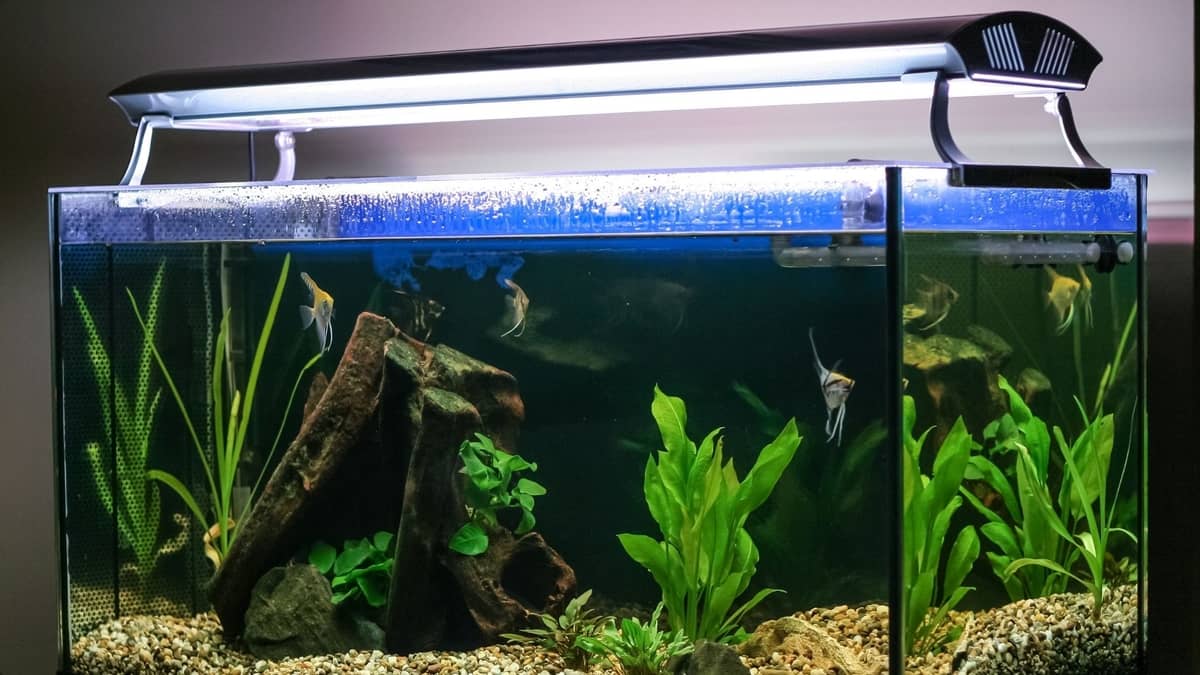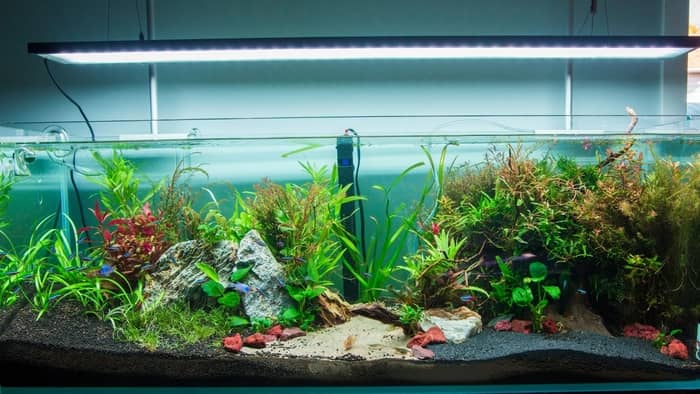Last Updated on October 9, 2021 by admins
Light is an essential aspect of plant life. So you may wonder, how much light do aquarium plants need? Just because plants grow underwater doesn’t mean they don’t need light.
With the right lighting and plants, any aquarium can thrive with live plants. Live plants are not only nice to look at, but they also create a healthy environment in your fish tank. With the proper care, anyone can have live plants in their aquarium.
How Many Hours Of Light Do Aquarium Plants Need?
On average, aquarium plants need eight to 12 hours of light each day. Oftentimes, 10 hours of light is a good starting point to begin at.
The amount of light the plants in your fish tank need will vary by several factors. They include how many plants you have, the type of plants and fish, the ambient lighting in your room, and the amount of algae in your tank.
Providing light is necessary so your plants can undergo photosynthesis. The same as land plants, aquatic plants use light in order to synthesis food from carbon dioxide and water. They are able to create photosynthesis from both ambient light and aquarium lights.
Type Of Fish and Plants
When getting plants for your fish tank, you want to ensure they come from the same type of environment as your fish. You don’t want to have fish and plants in the same tank that have totally different needs from each other. You want to have fish and plants that are compatible with each other’s environmental needs.
Depending on the types of plants you have, they will either need low medium, or high lighting. The level of lighting will be determined by the watts of the lights.
Learn more about: Who Makes Top Fin Aquariums?
Ambient Lighting
In some cases, the amount of ambient lighting in your room will affect how much aquarium lighting you need. If your aquarium is in a sunny south-facing sunroom with lots of windows or a family room with lots of lighting, you may not need as much aquarium lighting.
It will also depend on the personal needs of your fish. However, a room with really good ambient lighting will likely not need 12 hours of aquarium lights.
Algae Levels
Algae thrive off many things including lots of light, stagnant or slow-moving water, and a dirty tank. If your fish tank is prone to growing algae, you will want to reduce the lighting in your aquarium.
If you see a burst an algae growth, you will want to reduce how many hours the lights are on in your aquarium. In addition, you will also want to make sure your fish tank is not in direct sunlight as natural light is more likely to cause algae growth.
Number Of Plants In Your Fish Tank
If you have several plants in your fish tank, you will want to make sure to provide plenty of light so they all get some. With just one or two plants, you can likely get away with a smaller light.
Aquarium Light Schedule
The easiest and most efficient way to create a light schedule in your aquarium is with a timer. This makes it simple, as you don’t have to worry about remembering to turn on or off your aquarium lights every day.
When starting a light schedule, it is best, to begin with 10 hours of light a day. So, you can set your lights on a timer from 7 am- 5 pm or 8 am- 6 pm, depending on your preference. This is a good amount of time to start with, as you can easily increase it or decrease it depending on the needs of your fish.
The ideal light schedule will depend on the species of your plants and fish. Be sure to properly research their needs to ensure you are providing the right amount of light.
Planted Aquarium LED Lighting Guide
There are different types of lights you can use for your aquarium such as LED, fluorescent and incandescent. LED is becoming one of the most popular lighting options that people choose for their aquariums.
Specialty fluorescent lights are available that are designed specifically for plant life. Though they can be a reliable option, they are not as energy-efficient as other options.
Though incandescent lights were once a common choice, they are now becoming outdated. They are expensive to operate when compared to LED and fluorescent lighting and they also give off a lot of heat. In addition, they have a short light span and can only penetrate the water 12 inches.
LED lights have the ability to penetrate the water up to 24 inches. Even the most basic and affordable LED lighting setups can promote healthy plant growth. They are energy efficient and available in many different styles, including remote operated.
For plants that need just low lighting, 0.25 watts per liter (WPL) of water is generally sufficient. For plants that need medium lighting, 0.50 WPL is needed. In aquariums with plants that need high light, 0.80 WPL or more is the best option.
LED aquarium lights often come with a moonlight setting. After having the regular LED lights on during the day, you can switch to moonlight, which allows you to view your fish and plants without bothering them. Having a remote and timer for your LED lights allows you to easily create the schedule you need for your plants.
Providing The Proper Lighting For Aquarium Plants
Just like land plants, aquarium plants need proper lighting so they can undergo photosynthesis. Most aquarium plants will need eight to 12 hours of light each day. However, this will vary based on the type of plants and fish you have, the number of plants, ambient lighting, and algae growth.
The main types of lighting used for aquarium plants are LED, fluorescent, and incandescent. Though fluorescent can be a good option, incandescent is outdated. However, LED lights are becoming a popular choice thanks to their many benefits for aquarium life.
Do you have any questions regarding how much light do aquarium plants need? If so, please ask any questions regarding aquarium lighting for plants in the comment section below.

